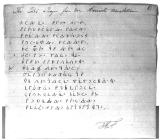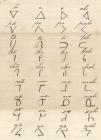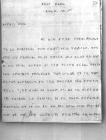2
Robert Rundle was only 21 years of age when he came to North America. He arrived at Norway House in present-day Manitoba: minimally educated, inexperienced and uncertain, a missionary about to enter his first mission field.4
Gerald Hutchinson:… He really started his mission work during his first stay in Norway House. As you can imagine, this young Englishman had very little education and a short course in business college. And then he decided that he would now be Methodist rather than Church of England. His father stayed in the Church of England, but his mother was Methodist and he didn't decide until he was 21 that he was going to be Methodist. He had a very famous uncle who was a Methodist missionary and so he decided he would follow in this line and started in theological college. But he was there only two to three months when this invitation to North America came along...
6
Gerald Hutchinson:… But he was so afraid and had nightmares about meeting Aboriginal people. He had not seen any-anywhere, but on the other hand had a sympathy for poor people. He got to Norway House and stayed for two months, waiting for James Evans to arrive. And there he encountered a friendly group of Aboriginal people who were well known around the fort. The Chief Factor was friendly and everything just went his way. And he discovered there that when he preached in the fort, some people would come. But in the afternoon when he went to their homes, they were quite excited. And by the time he went to their village, everybody was there. To Rundle, that was a great eye opener. When he went to them he got a response that he didn't get when he was in the Company confines. That was his first lesson.
And out of it then, as he said, he now lost all fear of Indian people. Now he said, "My chief delight is to be with them." And that became his operating principle for his time thereon...
8
From that first encounter, while waiting at Norway House for the arrival of Methodist missionary superintendent James Evans, Rundle overcame his hesitation. He preferred to be among the Aboriginal people of the region and live in their encampments, rather than the confines of Hudson's Bay Company posts. In the following years, from Fort Edmonton, he would travel north to Lesser Slave Lake, east to Whitefish, Fort Pitt and Carlton House and south nearly to the present-day Canada- U.S. border.10
Gerald Hutchinson:… He was dependent at first on interpreters. But the great asset for him was the development of the Cree syllabic. That became the most important single factor that enabled the mission to native peoples to proceed. We've lost our understanding and appreciation of the importance of Cree syllabic in this work...
12
Now, we call this writing form Cree syllabic but that sets up a limitation, as if it was only for the Cree language. This is not so. It is a kind of picture form of writing that works for any language. It could be English syllabics-- it was first used for Ojibway syllabic. But with slight modification, it's just pictures of sound so if you put English sounds into it, you're reading English script. The significance was that he could use this for Stoney, he could use this for Cree, he could use it for Blackfoot - these were primarily the groups he was meeting.13
The Lords Prayer translated into Cree and written in syllabic script by John Harriott.1843
Rocky Mountain House, Alberta

14
Gerald Hutchinson:... And so Rundle translated hymns, texts and prayers in Cree. So they had that as a start for mission work. He would write out what he called a Sunday Book. The people would take it home with them. And if only one person in the camp learned how to read this picture language, he could read it out to the rest of the band. So the knowledge that he was trying to convey of gospel-- through hymns, prayers and such-- was conveyed to Aboriginal people in their own language under their own leadership. Each camp developed its own reader and leader and there was no domination or threat that was used in evangelizing-- it was largely something that First Nations took on themselves and used.





